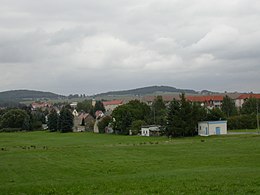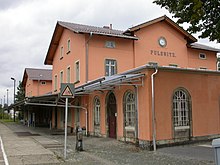Pulsnitz
| coat of arms | Germany map | |
|---|---|---|

|
Coordinates: 51 ° 11 ' N , 14 ° 1' E |
|
| Basic data | ||
| State : | Saxony | |
| County : | Bautzen | |
| Management Community : | Pulsnitz | |
| Height : | 290 m above sea level NHN | |
| Area : | 26.75 km 2 | |
| Residents: | 7468 (Dec. 31, 2019) | |
| Population density : | 279 inhabitants per km 2 | |
| Postal code : | 01896 | |
| Area code : | 035955 | |
| License plate : | BZ, BIW, HY, KM | |
| Community key : | 14 6 25 450 | |
| LOCODE : | DE PSI | |
| City structure: | 4 districts | |
| Association administration address: | At market 1 | |
| Website : | ||
| Mayoress : | Barbara Lüke (independent) | |
| Location of the city of Pulsnitz in the Bautzen district | ||
Pulsnitz ( Upper Sorbian Połčnica ) is a small Saxon town in the Bautzen district on the western edge of Upper Lusatia , about 10 km south of Kamenz and about 25 km northeast of the state capital Dresden . Pulsnitz is the seat of the administrative association Pulsnitz .
Pulsnitz is known nationwide as the gingerbread town .
geography
Geographical location
The old town lies on a hill above the Pulsnitz valley, the river of the same name (the Pulsnitz ) rises in the neighboring village of Ohorn . The small town is embedded in the hills of the West Lusatian hills and mountains (up to 448 m). The hilltops are mostly forested.
Neighboring communities
Neighboring communities are (clockwise) Haselbachtal , Steina , Ohorn , Großröhrsdorf , Lichtenberg and Großnaundorf .
City structure
In addition to the core city, three districts belong to the city of Pulsnitz: Friedersdorf , Friedersdorf Siedlung and Oberlichtenau . The village of Pulsnitz has been part of the city for a long time and describes the lower town in the Pulsnitz valley. The original city of Pulsnitz was divided into Vollung, Stadt and Meissen side.
history
Pulsnitz, like many other places in Upper Lusatia, was first mentioned in a document on May 19, 1225, as a police officer . A Sorbian settlement with a moated castle had already developed here . Pulsnitz became the seat of a noble family who had a small castle built here.
The place name, which comes from Sorbian , is derived from the name of the water body, which Ernst Eichler and Hans Walther put back in Old Sorbian * Połźnica , from * połz- ("crawl"), which means "creeping (slowly flowing) water".
1355 was Polßnitz by Emperor Charles IV. The market law , only 20 years later (1375) the city charter . At the beginning of the 15th century, the Hussites devastated Upper Lusatia. The Hussites also invaded Pulsnitz in 1429 (not for the first time). The oldest rural fortification, Perfert, dates from this time . Construction work on the Pulsnitz town hall began around 1500, the remains of which can still be seen in the Ratskeller building today.

On January 1, 1558, the Pulsnitz bakers were given the right to bake gingerbread for the first time . In 1580 Hans Wolf von Schönberg acquired Pulsnitz with its pertinence places from the von Schlieben brothers. He withdrew the lower jurisdiction of the council and tried to force the citizens to buy malt and other necessary things only from him. They complained to the emperor and even carried out an assassination attempt against Schönberg. Pastor A. Ricchius (son of the first Protestant pastor in the city, Andreas Ricchius) showed solidarity with the citizens and was dismissed.
In 1869, Pulsnitz was connected to the newly built Arnsdorf – Pulsnitz – Kamenz railway . In the following period an industrial boom began. At the end of the Second World War in 1945, the city remained largely unscathed despite heavy fighting in Upper Lusatia.
Incorporations
The former municipality of Pulsnitz, Meißner Seite was incorporated on April 1, 1948. On January 1, 1994, the previously independent community Friedersdorf was incorporated with Friedersdorf Siedlung. On January 1, 2009, the former neighboring community of Oberlichtenau followed . This last incorporation increased the urban area from 16.69 km² to 26.72 km².
Population development
Development of the population (from 1960 December 31) :
|
|
|
|
- Data source from 2000: State Statistical Office Saxony
coat of arms
Description : A black bear paw in gold .
politics
Municipal council
Since the municipal council election on May 26, 2019 , the 17 seats of the city council have been distributed among the individual groups as follows:
| list | CDU | FDP | AfD | LEFT | Green | SPD | ABW * |
| Seats 2019 | 5 | 5 | 3 | 1 | 1 | 0 | 2 |
|---|---|---|---|---|---|---|---|
| Seats 2014 | 6th | 5 | - | 2 | - | 1 | 3 |
* Active citizen voter association
Town twinning
Pulsnitz's twin town is Złotoryja (Goldberg) in the Polish Lower Silesian Voivodeship . There are friendly contacts with Asperg in Baden-Württemberg .
Culture and sights
Museums
- The city museum provides information about the history and famous personalities of the city.
- In the gingerbread museum, you can bake your own gingerbread in a workshop.
- In the gallery in the Hans-Rietschel-Haus the Ernst-Rietschel-Kulturring eV shows changing art exhibitions.
- Further exhibitions take place in the East Saxon art gallery, which is also supported by the Rietschel culture ring.
Buildings
- Rural defense system Perfert (also Hussite house) from around 1420
- Medieval market square with town hall and Rietschel monument
- Saxon post distance column as a replica in front of the Schützenhaus (original block of letters and coat of arms from 1731 in the town hall)
- Old Renaissance and new Baroque Oberlichtenau Castle (1718) with a park in the English-French style
- Late Gothic St. Nicolai Church
- Bible garden with miniature replica of a Byzantine basilica in Oberlichtenau
Mountains and viewpoints
- A few kilometers east of Pulsnitz near the municipality of Steina is the Schwedenstein , a 420 m high mountain whose observation tower offers a good all-round view of the West Lusatian hills.
- About six kilometers northwest of the city center, in the area of the Pulsnitz district of Oberlichtenau, lies the 413 m high Keulenberg , which is also a hiking destination and offers a good view.
- The Eierberg lies in the direction of Radeberg .
Culinary specialties
Pulsnitz is widely known as the gingerbread town. In addition to many other varieties, the Pulsnitz lace is a specialty. It is a Pulsnitzer gingerbread filled with various jams , which is also covered with chocolate.
Economy and Infrastructure
traffic
Pulsnitz is three kilometers north of the federal motorway 4 . State road 95 runs through the village , which also leads to the Pulsnitz junction near Leppersdorf .
The Kamenz – Pirna railway runs through Pulsnitz and is served every hour by the SB34 Dresden – Kamenz regional line.
Established businesses
The place has always been characterized by small and medium-sized companies in the manufacturing and trading sectors. Above all, potters ( Lusatian ceramics ), cloth printers ( blueprint ) and the currently eight private pepper cakes and a gingerbread factory shaped and continue to shape the image of the city. A traditional Black Forest company had oil and gas-fired ovens built here. In 2000 the production was taken over by the Hilden company Wachtel .
Two private rehabilitation clinics make Pulsnitz an important medical location, one clinic is housed in the castle.
media
The official bulletin is the Pulsnitzer Anzeiger . As the local newspaper for Pulsnitz and the surrounding area, it has been published monthly since July 1990 with a current circulation of 2,500 copies. The Pulsnitzer cable newspaper can also be received via the local television cable network.
Personalities
sons and daughters of the town
- 1561: Balthasar Kestner , royal Schaumburg court tailor, chamberlain and councilor of Bückeburg
- 1682: Bartholomäus Ziegenbalg , first Protestant missionary and Indian linguist
- 1802: Karl Eisner , musician and composer
- 1804: Ernst Rietschel , one of the most important sculptors of his time.
He created such well-known monuments as the Goethe-Schiller monument in Weimar . The Rietschel monument on the market square was designed and implemented by his student Gustav Kietz . - 1825: Julius Kühn , an important agricultural scientist, founded the first agricultural institute at a German university.
- 1840: Alwin Hartmann , member of the Reichstag and president of the regional court in Plauen
- 1847: Georg Hempel , entrepreneur, member of the Reichstag and Landtag
- 1851: Walther Hempel , chemist, co-founder of technical gas analysis
- 1869: Alwin Peschke , composer, conductor of the 2nd Guard Dragoons Regiment in Berlin from 1900 to 1918 (chief musician) and cornet player
- 1879: Rudolf Stempel , pastor, martyr of the Evangelical Church
- 1897: Curt Haase , politician (NSDAP)
- 1908: Robert Johannes Classen , businessman and astronomer
- 1932: Günter Haase , geographer
- 1933: Klaus Thielmann , medicine professor, GDR health minister in the Modrow government
- 1938: Klaus Staeck , graphic artist
- 1939: Hartmut Bonk , sculptor and graphic artist, from 1988 professor at the University of Fine Arts in Berlin-Charlottenburg.
Other personalities
- Max Schreyer (1845–1922), chief forestry officer, poet of the song Dar Vuglbärbaam , spent the last years of his life in Pulsnitz.
- Hulda von Levetzow (1863–1947), author, spent the last years of her life in Pulsnitz.
- Hermann Linke (1866–1925), trade unionist, Pulsnitz executive director of the textile workers' association, member of the Saxon state parliament.
- Erich Stange (1888–1972), Protestant pastor in Pulsnitz, Reichswart of the Evangelical Young Men’s Union and one of the founders of telephone pastoral care in Germany.
- Roswitha Neubarth (1928–2010), composer.
literature
- Rüdiger Rost, Horst Oswald: History of the city of Pulsnitz. From the beginning to the year 2000 . Oberlausitzer Verlag, Spitzkunnersdorf 2000, ISBN 3-933827-14-0 .
- Lausitzer Bergland around Pulsnitz and Bischofswerda (= values of our homeland . Volume 40). 1st edition. Akademie Verlag, Berlin 1983.
Individual evidence
- ↑ Population of the Free State of Saxony by municipalities on December 31, 2019 ( help on this ).
- ^ Ernst Eichler, Hans Walther: Historical book of place names of Saxony. Volume II (M – Z), Akademie-Verlag, Berlin 2001, p. 230
- ^ Federal Statistical Office (Ed.): Municipalities 1994 and their changes since January 1, 1948 in the new federal states . Metzler-Poeschel, Stuttgart 1995, ISBN 3-8246-0321-7 .
- ↑ StBA: Changes in the municipalities in Germany, see 1994
- ↑ StBA: Area changes on 01/01/2009
- ↑ Pulsnitz in the Digital Historical Directory of Saxony
- ↑ Statistics Saxony: Results of the 2019 municipal council elections in Pulsnitz , accessed on July 25, 2019
- ↑ City of Pulsnitz website ( Memento of the original from June 10, 2016 in the Internet Archive ) Info: The archive link was inserted automatically and has not yet been checked. Please check the original and archive link according to the instructions and then remove this notice.
- ↑ City of Asperg website ( Memento of the original from July 16, 2014 in the Internet Archive ) Info: The archive link was inserted automatically and has not yet been checked. Please check the original and archive link according to the instructions and then remove this notice.
Web links
- www.pulsnitz.de
- Pulsnitz in the Digital Historical Directory of Saxony
- Pulsnitz, Meißner page in the digital historical directory of Saxony














